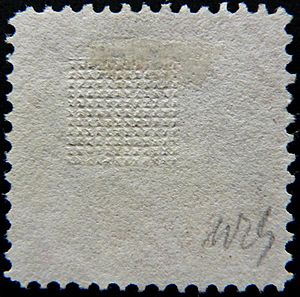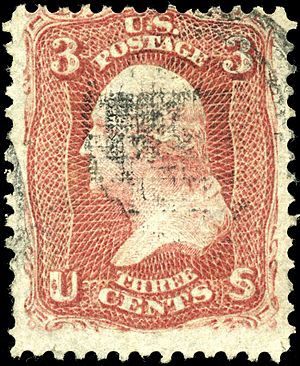Grill (philately) facts for kids
A grill on a postage stamp is a special pattern pressed into the stamp. It looks like tiny bumps or ridges. This was done to stop people from reusing stamps. In the United States, grills were used in the 1860s and 1870s. The idea was to help the ink from the cancellation mark soak deeper into the stamp's paper. This made it much harder to wash off the ink and use the stamp again.
Contents
Why Stamps Had Grills
Imagine a tiny waffle pattern pressed onto a stamp! That's what a grill is. The main reason for adding these grills was to prevent fraud. Back then, some people would try to wash the cancellation marks off used stamps. Then, they would try to use the stamps again.
How Grills Stopped Reuse
The grills broke the paper fibers of the stamp. This made the paper more absorbent. When the post office marked the stamp, the ink would sink deep into the paper. This made it very hard to remove the cancellation mark. It helped make sure stamps were only used once.
The idea for grilling stamps came from Charles F. Steel. He worked at the National Bank Note Company. This company printed stamps for the U.S. government. He suggested the idea in 1865.
Grills in the United States
The United States is famous for using grills on its stamps. Most grilled stamps come from the late 1860s and early 1870s. During this time, almost all U.S. stamps had grills. This makes grills a special area of study for stamp collectors, also called philatelists, in America.
Early Grill Experiments
The very first grill type was called the "A" grill. It covered the entire stamp. These stamps were sent to post offices for testing in August 1867. The tests seemed to go well. So, the National Bank Note Company got a contract to grill all stamps.
However, grilling on a large scale was tricky. The process made the stamp sheets weak. They would often tear when being perforated or handled. Because of this, the company quickly switched to smaller, rectangular grill patterns. All later grills were of this smaller type.
Identifying Grill Types
The contract didn't say what kind of grill pattern to use. So, the company experimented with different designs. Many details about these changes are now lost. In the 1910s, a philatelist named William L. Stevenson created a system. He used letters to identify the different grill types. Later research helped figure out when each grill type was used.
- The 1861-68 stamp series did not use G, H, I, or J grills. These grills were introduced later.
- The 1869 stamp series only used the G grill.
- The 1870 stamp series used the H and I grills.
By the early 1870s, fears about stamp reuse had lessened. Grilling was slowly stopped. Some stamps from the Continental Bank Note Company even had the "J" grill as late as 1875. This company took over stamp production from National.
Different Types of Grills
Stamp collectors have identified many different grill patterns. They are named with letters. Here are some of the main types:
- A Grill - This was the first experimental grill, covering the whole stamp.
- C Grill - This grill had points facing up.
- Z Grill - This grill had points facing down, with horizontal ridges.
- D Grill - This grill had points facing down, with vertical ridges.
- E Grill - This grill had points facing down, with vertical or "X" ridges.
- F Grill - This grill had points facing down, with vertical or "X" ridges.
- B Grill - This grill had points facing up, with "X" ridges.
- G Grill - This grill had points facing down, with vertical ridges.
- H Grill - This grill had points facing down, with vertical ridges.
- I Grill - This grill had points facing down, with vertical ridges.
- J Grill - This grill had points facing down, with vertical ridges.
Less Common Grill Patterns
Some grill patterns were not used very much. The "B" and "C" Grills are found only on the three-cent stamp. The "D" Grill is found only on the two-cent and three-cent stamps. The "A" Grill is found only on the three-cent, five-cent, and thirty-cent stamps. These less common grills are often more valuable to collectors.
Rare Grills and Famous Stamps
While many grilled stamps are common, some grill patterns were used very little. These define some of the greatest rarities in stamp collecting.
The Z Grill
The 1-cent stamp with the "Z" grill is one of the rarest U.S. stamps. Only two copies are known to exist! It is often simply called the Z Grill.
Other Rare Grills
A very rare stamp is the 30-cent "I" grill stamp. Only one example of this stamp has been found so far. Other very rare U.S. grilled stamps include:
- 30-cent I Grill (1 known copy)
- 1-cent Z Grill (2 known copies)
- 15-cent Z Grill (2 known copies)
- 12-cent I Grill (2 known copies)
- 90-cent I Grill (3 known copies)
- 3-cent B Grill (4 known copies)
- 5-cent A Grill (4 known copies)
- 10-cent Z Grill (6 known copies)
- 30-cent A Grill (8 known copies)
It's important to note that studies of the "I" Grill are still fairly new. More copies of "I" Grill stamps might be found in the future!
The B Grill Story
Only four stamps with the "B grill" pattern are known to exist. All of them are three-cent stamps and have been used. These four stamps came from a letter sent to Prussia (a country in Europe) in 1869.
The letter was found in 1969. This discovery caused a lot of excitement among stamp collectors. One of these "B grill" stamps was sold for $85,000 in 1993. Another one sold for about $155,000 in 1998. In 2008, the same stamp was sold again for over one million dollars! This shows how valuable rare stamps can be.
Grills in Other Countries
After the National Bank Note Company stopped making U.S. stamps in 1873, they started printing stamps for Peru. Their contract with Peru also required using the grilling process.
Peru used three different types of grills on its stamps between 1874 and 1884. One of these Peruvian grills looks like the American Z grill, with horizontal ridges. However, the Peruvian version is smaller. The other two Peruvian grills also have different sizes.



